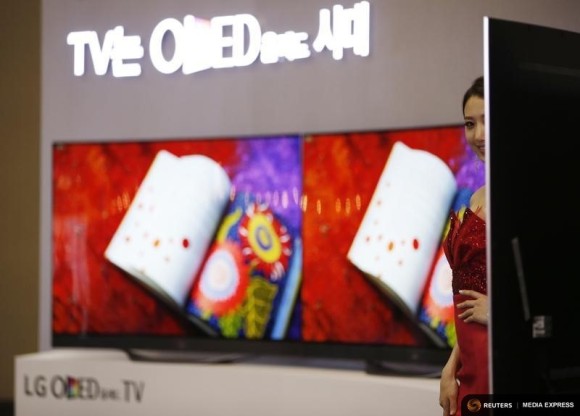SEOUL (Reuters) – South Korea’s LG Display Co Ltd said on Monday it would focus investment on organic light-emitting diode (OLED) displays, betting on the next-generation technology to steer it clear of price wars and ahead of the competition.
Through 2018, LG Display plans to put at least 10 trillion won ($8.47 billion) primarily into OLED displays for large products such as TVs, and flexible screens for smartphones and wearables. It will seek to expand OLED applications to signage and automobiles, and allocate some spending to premium liquid crystal display (LCD) products, the firm said in a statement.

LG Display and sister firm LG Electronics Inc have been the biggest proponents of OLED, which boasts improved color rendition and power consumption. The world’s top LCD maker hopes early investment in OLED will help it dominate when the technology becomes mainstream.
LG Display shares have fallen 34 percent this year, touching levels not seen since 2012 as investors see a future comprising sluggish LCD growth and profit-squeezing price wars with Chinese rivals. OLED, however, offers a market worth $28.3 billion by 2022 from $8.7 billion in 2014, said researcher DisplaySearch.
OLED is being increasingly adopted for premium smartphones and smartwatches, such as models from Samsung Electronics Co Ltd and Apple Inc. But prices of goods sporting large, high profit margin OLED screens such as TVs are still far higher than comparable LCD products.
A 55-inch OLED ultra-high definition curved TV made by LG Electronics was on sale for $4,999 on Amazon.com Inc’s U.S. shopping site, marked down from $5,499.99. A comparable LCD set made by Samsung was priced $2,497.99, down from $3,999.99.
Samsung, the world’s biggest TV maker, has said OLED is still too expensive to produce for TVs.
As the two LG companies are the only major players pushing the technology for TVs, analysts and investors are skeptical whether they can by themselves create the economies of scale necessary to bring down prices enough for mass market adoption.
(Reporting by Se Young Lee; Editing by Tony Munroe and Christopher Cushing)
If I could get a 55″ OLED TV for around $1,000 I’d do it. The picture looks great on them, but I think the wife would try to kill me in my sleep if I ever spent more than a grand on a TV.
Currently 55″ 4K OLED is $2500, 65″ 4K OLED is $7000.
Recent speculation on one forum is that the 65″ will still cost $3000+ in 2017.
Hope I’m wrong, but IMHO, it will be 2020 before 4K OLED approaches mass-market pricing.
And don’t forget those new HDTVs will need new tuners when ATSC 3.0 is approved, if you’re interested in receiving 4K OTA.
I presume some of that money will go to advancements prolonging the life of OLED in HDTV’s. I agree with the praises of OLED, and if we had robust OLED for HDTV’s today, 4K would not necessarily be getting all the attention it is today as OLED seems to exploit current HDTV spec for contrast and black levels that current LCD is not, aside from the other PQ benefits of OLED in HDTV’s. But right now, isn’t the life of OLED about one-third of LCD? That makes for a pretty poor value, even at a mere $100 for a, say, 65″-75.” Costs will come down, but if that can’t get OLED to be at least 2/3 the life of LCD and solve the nagging OLED dead (or delicate) pixel fact of life for OLED’s, then LG’s investment will be for naught.
Mmm, of course I meant to type $1,000 (one-thousand dollars) for a, say, 65″ to 75″ OLED HDTV or 4K, not one-hundred dollars.
It figures, we keep spending more and more money just to keep getting a better image quality… it’s getting to the point where it doesn’t really make a difference anymore.
While newer technologies are definitely making the image sharper and more clearer, there’s only so much the human eye can handle at one point. I even bought this 4k TV a little while ago (http://www.hdtvreviewsite.com/sony-xbr-55-inch-4k-hd-3d-smart-led-tv-review/), and it’s perfect… that’s the problem. At least I won’t have to buy one for years, but people spend too much time watching TV’s anyhow.
“It figures, we keep spending more and more money just to keep getting a better image quality”
Depends on whether or not you’re a ‘bleeding edger’ or not.
Personally, I’ve resisted 4K and OLED to this point, just cuz I’m not a bleeding edger. I buy when a significantly noticeable improvement hits mass-market pricing. So I keep getting better image quality, but only when the economics work. I’m willing to wait a year or two.
Currently, I’ve got zero interest in 4K, since it still doesn’t have content. But 1080 OLED is quite soon approaching mass-market pricing, so it’ll be time for me to upgrade for the first time in years. OLED matters.
(And, FWIW, 1080 OLED it’s coming to mass-market pricing before 4K has a critical mass of content, so it’ll be my initial upgrade.)
“I even bought this 4k TV a little while ago, and it’s perfect… that’s the problem. At least I won’t have to buy one for years”
Respectfully disagree. When OLED hits mass-market prices, which is quite soon approaching, you’ll want one. Or if you’re willing to continue being a bleeding edger, you’ll buy a 4K OLED panel relatively soon. Similarly, when 4K content achieves critical mass, and 4K OLED panels hit mass-market pricing, I’ll want one.